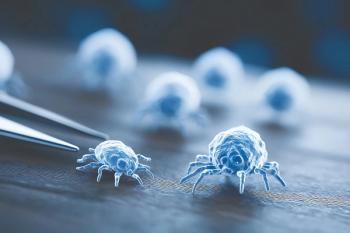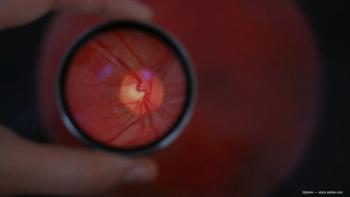
Science, theory support nutritional influences on today’s dry eye disease
The role of science and theory behind the nutritional influences on dry eye disease is explored by the co-authors.
Take home message
The role of science and theory behind the nutritional influences on dry eye disease is explored by the co-authors.
By Audrey Talley Rostov, MD, and Ellen Troyer, MT MA, Special to Ophthalmology Times
Dry eye disease today goes beyond thinking about increased tear evaporation versus decreased aqueous production. As evidence, it is now known the disease is multifactorial, inflammatory-mediated, and may include a combination of aqueous and evaporative factors (AAO PPP–Dry Eye Syndrome, 2013).
Further, newer diagnostic testing (AcuTarget HD, AcuFocus) and imaging can help the clinician in the dry eye diagnosis and provide objective means for patient education. Ocular surface imaging may provide diagnostic clues to refractive instability.
Treatment options for dry eye disease have included artificial tear supplementation, topical cyclosporine, topical steroids, and punctal occlusion. Now, nutritional supplementation (BioTears, Biosyntrx) is an area receiving more interest in the management of dry eye disease.
This article will focus on the science and theory behind nutritional influences on dry eye.
Nutritional deficiencies play a major role in a number of diseases, including dry eye.1 Oxidative stress and inflammation linked to nutritional deficiencies have been proven to affect the aging process, tear film biochemistry, and ocular surface health by inducing cornea and conjunctiva tissue damage, leading to visual impairment, and impaired quality of life.2
Oxidative stress is the biochemical endpoint of the imbalance between chemically reactive oxygen molecules and antioxidants. This imbalance interferes with the body’s ability to fight off cellular injury, including ocular injuries. Reactive molecules-including oxygen ions, peroxides, and ionizing radiation-can increase dramatically during the aging process and in times of physical, psychological, and environmental stress.3,4
Healthy tears provide key antioxidant molecules for preventing oxidative stress to the cornea and ocular surface. Evidence continues to grow that suggests oxidative stress is a contributing cause of dry eye disease. Oxidative stress affects blink response5 and three-layer tear film production, including lacrimal and meibomian gland output,6 as well as tear film base layer goblet cells and appropriate production of tear film mucins.7
All biomolecules can be attacked by reactive oxygen species, and cellular membrane lipids are the most likely to undergo destructive oxidation. Cellular membranes are fatty acid-dependent and extremely susceptible to oxidative damage.
Therefore, supplementing with fatty acids and additional nutrient co-factors may stimulate fatty-acid metabolism and may help prevent intracellular and extracellular oxidative destruction that can potentially damage ocular cells.8
The human body has nutrient-dependent, antioxidant defense systems to help control the destructive effects of continuous reactive oxygen species production. They are located in cytoplasm, cellular membranes, and extracellular spaces. Defenses include enzymatic intracellular mechanisms, such as superoxide dismutase (SOD) and metalloproteinase, that accelerate the dismution of superoxide to hydrogen peroxide, which is catalyzed into water or molecules of oxygen in the cytoplasm by copper and zinc (CuZnSOD) and catalyzed inside the mitochondrial by manganese (MnSOD).2,10
Free-radical scavengers
Scavenging nutrients slow the reactions of oxidation by transforming molecules into less-aggressive compounds. These nutrients are water-soluble vitamins, such as vitamin C and the B vitamins, or fat-soluble vitamins located in cellular membranes, such as vitamins A, E, and D, and specific carotenoids, including lutein and zeaxanthin.2
Green tea is also found in a few dry eye formulations. It is both water- and fat-soluble with potentially anti-inflammatory, anti-oxidative, and hyperosmolarity effects on the ocular surface.11
The essential fatty acid omega-6 linoleic acid (LA) is enzymatically metabolized down the delta six desaturase to gamma linoleic acid (GLA), which instantly converts to the mucosal-tissue-specific, anti-inflammatory prostaglandin series E1 if the nutrient co-factors are readily available, including vitamins C, E, and B6, and the minerals magnesium or zinc. This metabolic process can be affected by aging, alcohol, and prescription drugs (Figure 1 on Page 24).
Of all the omega-6 seed oils, only three include GLA: black currant seed oil, evening primrose seed oil, and borage oil. Black current seed oil may be considered the most stable because it includes a biochemically balanced amount of omega-6, omega-3, and omega-9 fatty acids.12
Curcumin, another nutrient with anti-inflammatory and hyperosmolarity activity, is also included in some dry eye nutritional formulations.13
Flaxseed oil may also be an effective anti-inflammatory for some patients. This alpha linolenic acid (ALA) omega-3 fatty acid quickly metabolizes to another fatty acid-steridonic acid (SDA) with anti-inflammatory properties.14
A small amount of flaxseed oil will metabolize further downstream to omega-3 eicosapentaenoic acid (EPA) and docosahexaenoic acid (DHA), which may potentially provide additional omega-3 DHA and address some meibomian gland cellular membrane lipid activity, thereby improving the tear film.
Omega-3 fatty acids EPA and DHA
Fish oil is one of the most commonly used nutritional supplements for dry eye. Fish oil alone does not address the role of oxidative stress in tear film dysfunction, and some additional nutritional formulations have been designed that incorporate both fish oil and nutritional co-factors.15-17
The base layer of the tear film, including goblet cells and mucin production, is vitamin A-dependent. Cod liver oil should be considered for dry eye, since it includes omega-3 EPA and DHA, as well as sufficient amounts of natural vitamin A retinol and vitamin D, which fish oil and flaxseed oil alone do not include.
In summary, nutritional supplementation can offer benefits to patients with dry eye and can provide clinicians with a safe treatment option. As research continues in the field of tear science, the hope is that expanded nutritional and other treatment options will become available.
Audrey Talley Rostov, MD, is a cornea and refractive surgeon with Northwest Eye Surgeons, Seattle, where she is a partner. She has no financial interest in Biosyntrx.
Ellen Troyer, MT MA, is chief executive officer and CRO at Biosyntrx.
References
1. Jalbert I. Diet, nutraceuticals and the tear film. Experimental Eye Research. 2013;117:138e146.
2. Duran M, Pinazo R, Medina J, Moreno V, Nucci C, Marco R, et al. Oxidative stress and its downstream signaling in aging eyes. Clin Interv Aging. 2014;2014;9:637-652.
3. Van der Vaart R, Weaver MA, Lefebvre C, David RM. The association between dry eye disease, depression and anxiety in a large population-based study. Am J Ophthalmol. 2014 Nov 26. pii: S0002-9394(14)00769-7. doi: 10.1016/j.ajo.2014.11.028. [Epub ahead of print]
4. Ames BN, Shigenaga MK. Oxidants are a major contributor to aging. Ann NY Acad Sci. 1992;663:85–96.
5. Nakamura S, Shibuya M, Nakashima H, Hisamura R, Nasuda N, Imagawa T, Uehara M, Tsubota K. Involvement of oxidative stress on corneal epithelial alterations in a blink-suppressed dry eye. Invest Ophthalmol Vis Sci. 2007;48:1552–1558.
6. Uchino Y, Kawakita T, Ishi T, Ishi N, Tsubota K. A new mouse model of dry eye disease: oxidative stress affects functional decline in the lacrimal gland. Cornea. 2012;31:S3-S8.
7. Mamoru T, Spurr-Michaud S, Tisdale A, Gipson I. Vitamin A deficiency alters the expression of mucin genes by the rat ocular surface epithelium. Invest Ophthamol Vis Sci. 2000;41:82-88.
8. Warnakulasuriya SN, Ziaullah, Rupasinghe HP. Long chain fatty acid acylated derivatives of quercetin-3-o-glucoside as antioxidants to prevent lipid oxidation. Biomolecules. 2014;4:980-993.
9. Baudouin C. Revisiting meibomian gland dysfunction. J Fr Ophthalmol. 2014;37:757-762.
10. Kojima T, Wakamatsu TH, Dogru M, et al. Age-related dysfunction of the lacrimal gland and oxidative stress: evidence from the Cu, Zn-superoxide dismutase-1 (Sod1) knockout mice. Am J Pathol. 2012;180:1879-1896.
11. Cavet M, Harrington K, Vollmer T, Ward K, Zhang J, Anti-inflammatory and anti-oxidative effects of the green tea polyphenol epigallocatechin gallate in human corneal epithelial cells. Molecular Vision. 2011;17:533–542.
12. Tahvonen RL, Schwab US, et al. Black currant seed oil and fish oil supplements differ in their effects on fatty acid profiles of plasma lipids, and concentrations of serum total and lipoprotein lipids, plasma glucose and insulin. J Nutr Biochem. 2005,16:353-359.
13. Curcumin protects against hyperosmoticity-induced IL-1beta elevation in human corneal epithelial cell via MAPK pathways. Exp Eye Res. 2010;90:437-443.
14. Zhu W Wu Y, Wang J, Li X. Efficacy of polyunsaturated fatty acids for dry eye syndrome: a meta-analysis of randomized controlled trials. Nutr Rev. 2014;72:662-671.
15. Harauma A. Salto J, et sl. Potential for daily supplementation of n-3 fatty acids to reverse symptoms of dry eye in mice. Prostaglandins Leukot Essent Fatty Acids. 2014;90:207–213.
16. Kangari H, Eftekhari MH, Sardari S, et al. Short-term consumption of oral omega-3 and dry eye syndrome. Ophthalmology. 2013;120:2191-2196.
17. Aurette ME. Dietary omega-3 PUFA and health: stearidonic acid-containing seed oils as effective and sustainable alternatives to traditional marine oils. Mol Nutr Food Res. 2013;57:748-759.
18. Barabino S, Rolando M, Camicione P, Ravera G, Zanardi S, et al. Systemic linoleic and gamma-linolenic acid therapy in dry eye syndrome with an inflammatory component. Cornea. 2003;22:97–101.
19. Arragona P, Bucolo C, Spinella R, Gluffrida S, Ferreri G. Systemic omega-6 essential fatty acid treatment and pge1 tear content in Sjogren’s syundrome patients. Invest Ophthalmol Vis Sci. 2005;46:4474–4479.
20. Sheppard JD Jr. Singh R, McClellan AJ, Weikert MP, Scoper SV, Joly TJ, Whitley WO, Kakkar E, Pfugfelder SC. Long-term supplementation with n-6 and n-3 PUFAs improves moderate to-severe Keratoconjunctivitis Sicca. A randomized double-blind clinical trial. Cornea. 2013 Jul 23. [Epub ahead of print]
21. Kawashima M, Kawakita T, Inaba T, et al. Dietary lactoferrin alleviates age-related lacrimal gland dysfunction in mice. PloS One. 2012;7:e33148. Published online 2012 Mar 27.
Newsletter
Don’t miss out—get Ophthalmology Times updates on the latest clinical advancements and expert interviews, straight to your inbox.









































